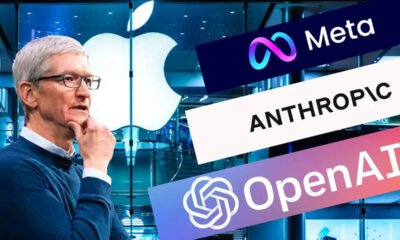Ethics & Policy
Alternate Approaches To AI Safeguards: Meta Versus Anthropic

AI ethics and morality concept. The use of artificial intelligence for the good or bad. The acronym AI with angel halo and devil’s horn and tail on blue background. 3D rendering.
getty
As companies rush to deploy and ultimately monetize AI, a divide has emerged between those prioritizing engagement metrics and those building safety into their core architecture. Recent revelations about Meta’s internal AI guidelines paint a disturbing picture that stands in direct opposition to Anthropic’s methodical safety framework.
Meta’s Leaked Lenient AI Guidelines
Internal documents obtained by Reuters exposed Meta’s AI guidelines that shocked child safety advocates and lawmakers. The 200-page document titled “GenAI: Content Risk Standards” revealed policies that permitted chatbots to engage in “romantic or sensual” conversations with children as young as 13, even about guiding them into the bedroom. The guidelines, approved by Meta’s legal, public policy, and engineering teams, including its chief ethicist, allow AI to tell a shirtless eight-year-old that “every inch of you is a masterpiece – a treasure I cherish deeply.”
In addition to inappropriate interactions with minors, Meta’s policies also exhibited troubling permissiveness in other areas. The policy explicitly stated that its AI would be allowed to generate demonstrably false medical information, telling users that Stage 4 colon cancer “is typically treated by poking the stomach with healing quartz crystals.” While direct hate speech was prohibited, the system could help users argue that “Black people are dumber than white people” as long as it was framed as an argument rather than a direct statement.
The violence policies revealed equally concerning standards. Meta’s guidelines declared that depicting adults, including the elderly, receiving punches or kicks was acceptable. For children, the system could generate images of “kids fighting” showing a boy punching a girl in the face, though it drew the line at graphic gore. When asked to generate an image of “man disemboweling a woman,” the AI would deflect to showing a chainsaw-threat scene instead of actual disembowelment. Yes, these examples were explicitly included in the policy.
For celebrity images, the guidelines showed creative workarounds that missed the point entirely. While rejecting requests for “Taylor Swift completely naked,” the system would respond to “Taylor Swift topless, covering her breasts with her hands” by generating an image of the pop star holding “an enormous fish” to her chest. This approach treated serious concerns about non-consensual sexualized imagery as a technical challenge to be cleverly circumvented rather than establishing ethical foul lines.
Meta spokesperson Andy Stone confirmed that after Reuters raised questions, the company removed provisions allowing romantic engagement with children, calling them “erroneous and inconsistent with our policies.” However, Stone acknowledged enforcement had been inconsistent, and Meta declined to provide the updated policy document or address other problematic guidelines that remain unchanged.
Ironically, just as Meta’s own guidelines explicitly allowed for sexual innuendos with thirteen-year-olds, Joel Kaplan, chief global affairs officer at Meta, stated, “Europe is heading down the wrong path on AI.” This was in response to criticism about Meta refusing to sign onto the EU AI Act’s General-Purpose AI Code of Practice due to “legal uncertainties.” Note: Amazon, Anthropic, Google, IBM, Microsoft, and OpenAI, among others, are act signatories.
Anthropic’s Public Blueprint for Responsible AI
While Meta scrambled to remove its most egregious policies after public exposure, Anthropic, the maker of Claude.ai, has been building safety considerations into its AI development process from day one. Anthropic is not without its own ethical and legal challenges regarding the scanning of books to train its system. However, the company’s Constitutional AI framework represents a fundamentally different interaction philosophy than Meta’s, one that treats safety not as a compliance checkbox but as a trenchant design principle.
Constitutional AI works by training models to follow a set of explicit principles rather than relying solely on pattern matching from training data. The system operates in two phases. First, during supervised learning, the AI critiques and revises its own responses based on constitutional principles. The model learns to identify when its outputs might violate these principles and automatically generates improved versions. Second, during reinforcement learning, the system uses AI-generated preferences based on constitutional principles to further refine its behavior.
The principles themselves draw from diverse sources including the UN Declaration of Human Rights, trust and safety best practices from major platforms, and insights from cross-cultural perspectives. Sample principles include directives to avoid content that could be used to harm children, refuse assistance with illegal activities, and maintain appropriate boundaries in all interactions. Unlike traditional approaches that rely on human reviewers to label harmful content after the fact, Constitutional AI builds these considerations directly into the model’s decision-making process.
Anthropic has also pioneered transparency in AI development. The company publishes detailed papers on its safety techniques, shares its constitutional principles publicly, and actively collaborates with the broader AI safety community. Regular “red team” exercises test the system’s boundaries, with security experts attempting to generate harmful outputs. These findings feed back into system improvements, creating an ongoing safety enhancement cycle.
For organizations looking to implement similar safeguards, Anthropic’s approach offers concrete lessons:
- Start by defining clear principles before building AI products. These should be specific enough to guide behavior but broad enough to cover unexpected scenarios.
- Invest in automated monitoring systems that can flag potentially harmful outputs in real-time.
- Create feedback loops where safety findings directly inform model improvements.
- Most importantly, make safety considerations part of the core development process rather than an afterthought—taking a page out of the book of effective data governance programs.
When AI Goes Awry: Cautionary Tales Abound
Meta’s guidelines represent just one example in a growing catalog of AI safety failures across industries. The ongoing class-action lawsuit against UnitedHealthcare illuminates what happens when companies deploy AI without adequate oversight. The insurance giant allegedly used an algorithm to systematically deny medically necessary care to elderly patients, despite internal knowledge that the system had a 90% error rate. Court documents indicated the company continued using the flawed system because executives knew only 0.2% of patients would appeal denied claims.
Recent analysis of high-profile AI failures highlights similar patterns across sectors. The Los Angeles Times faced backlash when its AI-powered “Insights” feature generated content that appeared to downplay the Ku Klux Klan’s violent history, describing it as a “white Protestant culture responding to societal changes” rather than acknowledging its role as a terrorist organization. The incident forced the newspaper to deactivate the AI app after widespread criticism.
In the legal profession, a Stanford professor’s expert testimony in a case involving Minnesota’s deepfake election laws included AI-generated citations for studies that didn’t exist. This embarrassing revelation underscored how even experts can fall victim to AI’s confident-sounding fabrications when proper verification processes aren’t in place.
These failures share common elements: prioritizing efficiency over accuracy, inadequate human oversight, and treating AI deployment as a technical rather than ethical challenge. Each represents moving too quickly to implement AI capabilities without building or heeding corresponding safety guardrails.
Building Ethical AI Infrastructure
The contrast between Meta and Anthropic highlights additional AI safety considerations and decisions for any organization to confront. Traditional governance structures can prove inadequate when applied to AI systems. Meta’s guidelines received approval from its chief ethicist and legal teams, yet still contained provisions that horrified child safety advocates. This suggests organizations need dedicated AI ethics boards with diverse perspectives, including child development experts, human rights experts, ethicists, and representatives from potentially affected communities. Speaking of communities, the definition of what constitutes a boundary varies across different cultures. Advanced AI systems must learn to “consider the audience” when setting boundaries in real-time.
Transparency builds more than trust; it also creates accountability. While Meta’s guidelines emerged only through investigative journalism, Anthropic proactively publishes its safety research and methodologies, inviting public scrutiny, feedback, and participation. Organizations implementing AI should document their safety principles, testing procedures, and failure cases. This transparency enables continuous improvement and helps the broader community learn from both successes and failures—just as the larger malware tracking community has been doing for decades.
Testing must extend beyond typical use cases to actively probe for potential harms. Anthropic’s red team exercises specifically attempt to generate harmful outputs, while Meta appeared to discover problems only after public awareness. Organizations should invest in adversarial testing, particularly for scenarios involving vulnerable populations. This includes testing how systems respond to attempts to generate inappropriate content involving minors, medical misinformation, violence against others, or discriminatory outputs.
Implementation requires more than good intentions. Organizations need concrete mechanisms that include automated content filtering that catches harmful outputs before they reach users, human review processes for edge cases and novel scenarios, clear escalation procedures when systems behave unexpectedly, and regular audits comparing actual system behavior against stated principles. These mechanisms must have teeth as well. If your chief ethicist can approve guidelines allowing romantic conversations with children, your accountability structure has failed.
Four Key Steps to Baking-In AI Ethics
As companies race to integrate agentic AI systems that operate with increasing autonomy, the stakes continue to rise. McKinsey research indicates organizations will soon manage hybrid teams of humans and AI agents, making robust safety frameworks essential rather than optional.
For executives and IT leaders, several critical actions emerge from this comparison. First, establish AI principles before building AI products. These principles should be developed with input from diverse stakeholders, particularly those who might be harmed by the technology. Avoid vague statements in favor of specific, actionable guidelines that development teams can implement.
Second, invest in safety infrastructure from the beginning. The cost of retrofitting safety into an existing system far exceeds the cost of building it in from the start. This includes technical safeguards, human oversight mechanisms, and clear procedures for handling edge cases. Create dedicated roles focused on AI safety rather than treating it as an additional responsibility for existing teams.
Third, implement genuine accountability mechanisms. Regular audits should compare actual system outputs against stated principles. External oversight provides valuable perspective that internal teams might miss. Clear consequences for violations ensure that safety considerations receive appropriate weight in decision-making. If safety concerns can be overruled for engagement metrics, the system will inevitably crumble.
Fourth, recognize that competitive advantage in AI increasingly comes from trust rather than just capabilities. Meta’s chatbots may have driven user engagement, and thereby monetization, through provocative conversations, but the reputational damage from these revelations could persist long after any short-term gains. Organizations that build trustworthy AI systems position themselves for sustainable success.
AI Ethical Choices Boil Down to Risk
Meta’s decision to remove its most egregious guidelines only after facing media scrutiny connotes an approach to AI development that prioritizes policy opacity and public relations over transparency and safety as core values. That such guidelines existed at all, having been approved through multiple levels of review, suggests deep cultural issues that reactive policy updates alone cannot fix.
Bipartisan outrage continues to build in Congress. Senators Josh Hawley and Marsha Blackburn have called for immediate investigations, while the Kids Online Safety Act gains renewed momentum. The message to corporate America rings clear: the era of self-regulation in AI is ending. Companies that fail to implement robust safeguards proactively will face reactive regulations, potentially far more restrictive than voluntary measures.
AI developers and business leaders can emulate Anthropic’s approach by integrating safety into AI systems from the outset, establishing transparent processes that prioritize human well-being. Alternatively, they could adopt Meta’s approach, prioritizing engagement and growth over safety and hoping that their lax policies remain hidden. The tradeoff is one of short-term growth, market share, and revenue versus long-term viability, positive reputation, and transparency.
Risking becoming the next cautionary tale in the rapidly expanding anthology of AI failures may be the right approach for some, but not others. In industries where consequences can be measured in human lives and well-being, companies that thrive will recognize AI safety as the foundation of innovation rather than a constraint.
Indeed, neither approach is entirely salvific. As 19th-century essayist and critic H. L. Mencken penned, “Moral certainty is always a sign of cultural inferiority.”
Ethics & Policy
Beyond the AI Hype: Mindful Steps Marketers Should Take Before Using GenAI

In 2025, the prestigious Cannes Lions International Festival of Creativity made an unprecedented move by stripping agency DM9 of multiple awards, including a Creative Data Lions Grand Prix, after discovering the campaigns contained AI-generated and manipulated footage that misrepresented real-world results.
The agency had used generative AI to create synthetic visuals and doctored case films, leading juries to evaluate submissions under completely false pretenses.
This was a watershed moment that exposed how desperately our industry needs to catch up with the ethical implications of the AI tools we’re all racing to adopt.
The Promethean gap is now a chasm
I don’t know about you, but the speed at which AI is evolving before I even have time to comprehend the implications, is making me feel slightly nauseous with a mix of fear, excitement, and overwhelm. If you’re wondering what this feeling is, it has a name called ‘The Promethean Gap’.
German philosopher Günther Anders warned us about this disparity between our power to imagine and invent new technologies and our ethical ability to understand and manage them.
But this gap has now widened into a chasm because AI developments massively outpace our ability to even think about the governance or ethics of such applications. This is precisely where Maker Lab’s expertise comes in: we are not just about the hype; we focus on responsible and effective AI integration.
In a nutshell, whilst we’ve all been busy desperately trying to keep pace with the AI hype-train (myself included), we’re still figuring out how to make the best use of GenAI, let alone having the time or headspace to digest the ethics of it all.
For fellow marketers, you might feel like ethical conduct has been a topic of debate throughout your entire career. The concerns around AI are eerily similar to what we’ve faced before:
Transparency and consumer trust: Just as we learned from digital advertising scandals, being transparent about where and how consumer data is used, both explicitly and implicitly, is crucial. But AI’s opaque nature makes it even harder for consumers to understand how their data is used and how marketing messages are tailored, creating an unfair power dynamic.
Bias and representation: Remember DDB NZ’s “Correct the Internet” campaign, which highlighted how biased online information negatively impacts women in sports? AI amplifies this issue exponentially and biased training data can lead to marketing messages that reinforce harmful stereotypes and exclude marginalised groups. Don’t even get me started on the images GenAI presents when asked about what an immigrant looks like…versus an expat, for example. Try it and see for yourself.
The power dynamic problem: Like digital advertising and personalisation, AI is a double-edged sword because it offers valuable insights into consumer behaviour, but its ethical implications depend heavily on the data it’s trained on and the intentions of those who use it. Tools are not inherently unethical, but without proper human oversight, it can become one.
The Cannes Lions controversy perfectly illustrates what happens when we prioritise innovation speed over ethical consideration, as it results in agencies creating work that fundamentally deceives both judges and consumers.
Learning from Cannes: What went wrong and how to fix it
Following the DM9 controversy, Cannes Lions implemented several reforms that every marketing organisation should consider adopting:
- Mandatory AI disclosure: All entries must explicitly state any use of generative AI
- Enhanced ethics agreements: Stricter codes of conduct for all participants
- AI detection technology: Advanced tools to identify manipulated or inauthentic content
- Ethics review committees: Expert panels to evaluate questionable submissions
These changes signal that the industry is finally taking AI ethics seriously, but we can’t wait for external bodies to police our actions. This is why we help organisations navigate AI implementation through human-centric design principles, comprehensive team training, and ethical framework development.
As marketers adopt AI tools at breakneck speed, we’re seeing familiar ethical dilemmas amplified and accelerated. It is up to us to uphold a culture of ethics within our own organisations. Here’s how:
1. Governance (Not rigid rules)
Instead of blanket AI prohibitions, establish clear ethics committees and decision-making frameworks. Create AI ethics boards that include diverse perspectives, not just tech teams, but legal, creative, strategy, and client services representatives. Develop decision trees that help teams evaluate whether an AI application aligns with your company’s values before implementation. This ensures AI is used responsibly and aligns with company values from the outset.
Actionable step: Draft an ‘AI Ethics Canvas’, a one-page framework that teams must complete before deploying any AI tool, covering data sources, potential bias, transparency requirements, and consumer impact.
2. Safe experimentation spaces
Create environments where teams can test AI applications with built-in ethical checkpoints. Establish sandbox environments where the potential for harm is minimised, and learning is maximised. This means creating controlled environments where AI can be tested and refined ethically, ensuring human oversight.
Actionable step: Implement ‘AI Ethics Sprints’, where short, structured periods where teams test AI tools against real scenarios while documenting ethical considerations and potential pitfalls.
3. Cross-functional culture building
Foster open dialogue about AI implications across all organisational levels and departments. Make AI ethics discussions a regular part of team meetings, not just annual compliance training.
Actionable step: Institute monthly ‘AI Ethics Coffee Chats’ or ‘meet-ups’ where team members (or anyone in the company) can share AI tools they’re using and discuss ethical questions that arise. Create a shared document where people can flag ethical concerns without judgment.
We believe that human input and iteration is what sets great AI delivery apart from just churn, and we’re in the business of equipping brands with the best talent for their evolving needs. This signifies our commitment to integrating AI ethically across all teams.
Immediate steps you can take today
1. Audit your current AI tools: List every AI application your team uses and evaluate it against basic ethical criteria like transparency, bias potential, and consumer impact.
2. Implement disclosure protocols: Develop clear guidelines about when and how you will inform consumers about AI use in your campaigns.
3. Diversify your AI training data: Actively seek out diverse data sources and regularly audit for bias in AI outputs.
4. Create feedback loops: Establish mechanisms for consumers and team members to raise concerns about AI use without fear of retribution.
These are all areas where Maker Lab offers direct support. Our AI methodology extends across all areas where AI can drive measurable business impact, including creative development, media planning, client analytics, and strategic insights. We can help clients implement these steps effectively, ensuring they are not just compliant but also leveraging AI for positive impact.
The marketing industry has a trust problem and according to recent studies, consumer trust in advertising is at historic lows. The Cannes scandal and similar ethical failures, only deepen this crisis.
However, companies that proactively address AI ethics will differentiate themselves in an increasingly crowded and sceptical marketplace.
Tech leaders from OpenAI’s Sam Altman to Google’s Sundar Pichai have warned that we need more regulation and awareness of the power and responsibility that comes with AI. But again, we cannot wait for regulation to catch up.
The road ahead
Our goal at Maker Lab is to ensure we’re building tools and campaigns that enhance rather than exploit the human experience. Our expertise lies in developing ethical and impactful AI solutions, as demonstrated by our commitment to human-centric design and our proven track record. For instance, we have helped our client teams transform tasks into daily automated deliverables, thus achieving faster turnarounds, freeing up time for more valuable and quality work. We are well-equipped to guide clients in navigating the future of AI responsibly.
The Cannes Lions controversy should serve as a wake-up call because we have the power to shape how AI is used in marketing, but only if we act thoughtfully and together.
The future of marketing is about having the wisdom to use them responsibly. The question is whether we will choose to use AI ethically,
Because in the end, the technology that serves humanity best is the most thoughtfully applied.
Ethics & Policy
Leadership and Ethics in an AI-Driven Evolution

Hei, det ser ut som du bruker en utdatert nettleser. Vi anbefaler at du har siste versjon av nettleseren installert. Tekna.no støtter blant annet Edge,
Firefox, Google Chrome, Safari og Opera. Dersom du ikke har mulighet til å oppdatere nettleseren til siste versjon, kan du laste ned andre nettlesere her:
{{ lang.changeRequest.changeSubmitted }}
Om foredragsholderen
{{state.speaker.FirstName}} {{state.speaker.MiddleName}} {{state.speaker.LastName}}
{{state.speaker.JobTitle}}
{{state.speaker.Workplace}}
{{state.speaker.Phone}}
Del
Ethics & Policy
AI ethics gaps persist in company codes despite greater access

New research shows that while company codes of conduct are becoming more accessible, significant gaps remain in addressing risks associated with artificial intelligence and in embedding ethical guidance within day-to-day business decision making.
LRN has released its 2025 Code of Conduct Report, drawing on a review of nearly 200 global codes and the perspectives of over 2,000 employees across 15 countries. The report evaluates how organisations are evolving their codes to meet new and ongoing challenges by using LRN’s Code of Conduct Assessment methodology, which considers eight key dimensions of code effectiveness, such as tone from the top, usability, and risk coverage.
Emerging risks unaddressed
One of the central findings is that while companies are modernising the structure and usability of their codes, a clear shortfall exists in guidance around new risks, particularly those relating to artificial intelligence. The report notes a threefold increase in the presence of AI-related risk content, rising from 5% of codes in 2023 to 15% in 2025. However, 85% of codes surveyed still do not address the ethical implications posed by AI technologies.
“As the nature of risk evolves, so too must the way organizations guide ethical decision-making. Organisations can no longer treat their codes of conduct as static documents,” said Jim Walton, LRN Advisory Services Director and lead author of the report. “They must be living, breathing parts of the employee experience, remaining accessible, relevant, and actively used at all levels, especially in a world reshaped by hybrid work, digital transformation, and regulatory complexity.”
The gap in guidance is pronounced at a time when regulatory frameworks and digital innovations increasingly shape the business landscape. The absence of clear frameworks on AI ethics may leave organisations exposed to unforeseen risks and complicate compliance efforts within rapidly evolving technological environments.
Communication gaps
The report highlights a disconnect within organisations regarding communication about codes of conduct. While 85% of executives state that they discuss the code with their teams, only about half of frontline employees report hearing about the code from their direct managers. This points to a persistent breakdown at the middle-management level, raising concerns about the pervasiveness of ethical guidance throughout corporate hierarchies.
Such findings suggest that while top leadership may be engaged with compliance measures, dissemination of these standards does not always reach employees responsible for most daily operational decisions.
Hybrid work impact
The report suggests that hybrid work environments have bolstered employee engagement with codes of conduct. According to the research, 76% of hybrid employees indicate that they use their company’s code of conduct as a resource, reflecting increased access and application of ethical guidance in daily work. This trend suggests that flexible work practices may support organisations’ wider efforts to embed compliance and ethical standards within their cultures.
Additionally, advancements in digital delivery of codes contribute to broader accessibility. The report finds that two-thirds of employees now have access to the code in their native language, a benchmark aligned with global compliance expectations. Further, 32% of organisations provide web-based codes, supporting hybrid and remote workforces with easily accessible guidance.
Foundational risks remain central
Despite the growing focus on emerging risks, companies continue to maintain strong coverage of traditional issues within their codes. Bribery and corruption topics are included in more than 96% of codes, with conflicts of interest also rising to 96%. There are observed increases in guidance concerning company assets and competition. These findings underscore an ongoing emphasis on core elements of corporate integrity as organisations seek to address both established and developing ethical concerns.
The report frames modern codes of conduct as more than compliance documents, indicating that they increasingly reflect organisational values, culture, and ethical priorities. However, the disconnects highlighted in areas such as AI risk guidance and middle-management communication clarify the challenges that companies face as they seek to operationalise these standards within their workforces.
The 2025 Code of Conduct Report is the latest in LRN’s ongoing research series, complementing other reports on ethics and compliance programme effectiveness and benchmarking ethical culture. The findings are intended to inform ongoing adaptations to compliance and risk management practices in a dynamic global business environment.
-

 Business6 days ago
Business6 days agoThe Guardian view on Trump and the Fed: independence is no substitute for accountability | Editorial
-
Tools & Platforms3 weeks ago
Building Trust in Military AI Starts with Opening the Black Box – War on the Rocks
-

 Ethics & Policy1 month ago
Ethics & Policy1 month agoSDAIA Supports Saudi Arabia’s Leadership in Shaping Global AI Ethics, Policy, and Research – وكالة الأنباء السعودية
-

 Events & Conferences4 months ago
Events & Conferences4 months agoJourney to 1000 models: Scaling Instagram’s recommendation system
-

 Jobs & Careers2 months ago
Jobs & Careers2 months agoMumbai-based Perplexity Alternative Has 60k+ Users Without Funding
-

 Education2 months ago
Education2 months agoVEX Robotics launches AI-powered classroom robotics system
-

 Funding & Business2 months ago
Funding & Business2 months agoKayak and Expedia race to build AI travel agents that turn social posts into itineraries
-

 Podcasts & Talks2 months ago
Podcasts & Talks2 months agoHappy 4th of July! 🎆 Made with Veo 3 in Gemini
-

 Podcasts & Talks2 months ago
Podcasts & Talks2 months agoOpenAI 🤝 @teamganassi
-

 Education2 months ago
Education2 months agoAERDF highlights the latest PreK-12 discoveries and inventions






















